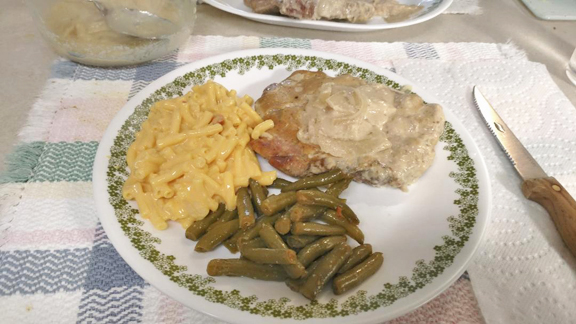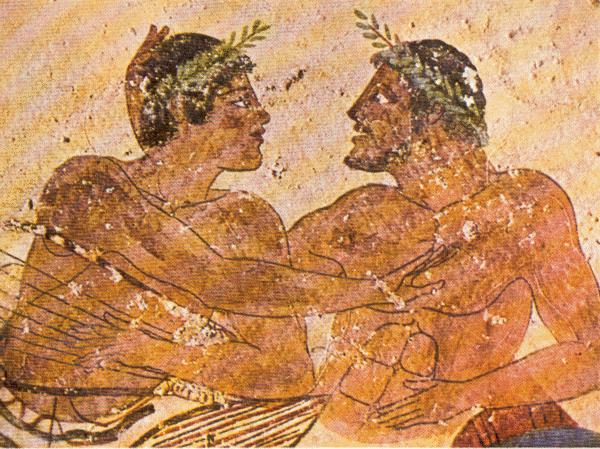Here is another slow cooking meal that insures your chops will be juicy and tender. It cooks on low for four hours! We dedicate it to the long lost gay community of ancient Pompeii. Read about them after the recipe.
Nice bone in chops, slow cooked in a soup based sauce, easy and juicy!
Ingredients:
4 pork chops, bone in (about 2 pounds)
1 onion, sliced
4 cloves garlic, minced
¼ cup flour
1 can evaporated milk
1 can cream of onion soup
2 tsp. paprika
2 tsp. garlic powder
1 tsp. poultry seasoning
1 tablespoon Dijon mustard
½ teaspoon each salt + pepper
Directions:
First, always wipe out your slow cooker and spray it.
Do your cutting: carefully slice the onion on a mandolin slicer. Mince the garlic.
Brown the pork chops on both sides in a large frying pan over high heat.
Add the sliced onion and the minced garlic in the bottom of the slow cooker. Place the pork chops on top. Set on LOW.
In a medium-sized bowl, whisk the evaporated milk together with the cream of onion soup and ¼ cup flour until blended. Stir in the mustard and the spices before pouring over the pork chops.
Cook on low for 4 hours.
Once ready, remove the pork chops from the slow cooker and serve with the cooking gravy.
Goes well with potatoes, rice or pasta and a green vegetable.
For our music: https://www.youtube.com/watch?v=wIiVp3poe2c
So honored to serve this to my Master on the occasion of his birthday!
socialslave
To satisfy and restore.
To nourish, support and maintain.
To gratify, spoil, comfort and please,
to nurture, assist, and sustain
…..I cook!
Please buy slave's cookbook:
The Little Black Book of Indiscreet Recipes by Dan White
http://www.amazon.com/dp/B00F315Y4I/ref=cm_sw_r_tw_dp_vAT4sb0934RTM via @amazon
===================================
The Boys of Pompeii
Back in 79 AD, Mt Vesuvius erupted burying Pompeii yet preserving the city.
The ash preserved homoerotic frescoes that Christianity would no doubt have destroyed had they not been covered.
The city was not completely buried, and tops of buildings were still above the ash making it obvious where to dig or salvage building material. But it was mostly forgotten.
Further eruptions particularly in 471–473 and 512 covered the remains more deeply.
Around 1700 the city of Pompeii and a sister city Herculaneum were “re-discovered” and work began on excavations.
When the artwork was first discovered, people found it so scandalous that much of it was locked away in the National Museum of Naples, where it remained hidden from view for over 100 years. In 2000, the art was finally made view-able to the public, but minors must be accompanied by an adult.
The art work was not just sexual, much of it was HOMOSEXUAL!
Largely preserved under the ash, the excavated city offered a unique look at Roman life, frozen at the moment it was buried. Historians got an extraordinarily detailed insight into the everyday life of its inhabitants, although much of the evidence was lost in the early excavations.
Organic remains, including wooden objects and human bodies, were entombed in the ash and decayed leaving voids which archaeologists found could be used as molds to make plaster casts of unique and often gruesome figures in their final moments of life. This technique is still in use today, with a clear resin now used instead of plaster because it is more durable, and does not destroy the bones, allowing further analysis.
Two such bodies were found wrapped in a poignant embrace as they were covered beneath molten rock and layers of ash. The heterocentric culture of the scientists assumed them to be two women. However that was not the case.
The bodies were originally dubbed “The Two Maidens” but in a startling discovery scientists found the two bodies were actually male – raising speculation that they may have been gay lovers.
“We always imagined that it was an embrace between women. But a CAT scan and DNA have revealed that they are men. “You can’t say for sure that the two were lovers. But considering their position, you can make that hypothesis. It is difficult to say with certainty.” said Massimo Osanna, director-general of the world-famous archaeological site.
One of the two bodies is lying at a right angle to the other and seen with his head resting on the other’s chest in search of comfort and perhaps protection.
Extensive anthropological tests of the duo’s bones and teeth have revealed that one of the them was a young man aged about 18 years of age while the second was probably an adult male aged about 2 years older. Buried for centuries, the tenderness and love still evokes feelings today.
Gay history was usually erased, but glimpses are preserved on the walls of Pompeii. One of the fascinating things preserved in Pompeii is the graffiti on the city walls where the thoughts of the people remain, uncensored by subsequent history.
One scratching on a wall reads, ” Phoebus the perfume sellers sucks real good.”
Others walls around Pompeii read like a truck stop bathroom, including some colorful gay comments:
On the bar-brothel of Innulus and Papilio:
Weep, you girls. My penis has given you up. Now it penetrates men’s behinds. Goodbye, wondrous femininity!
On the house of the Citharist below a drawing of a man with a large nose:
Amplicatus, I know that Icarus is buggering you. Salvius wrote this.
On the basilica:
Phileros is a eunuch!
On the Eumachia Building:
Secundus likes to screw boys.
On the house of Orpheus:
I have buggered men.
There is a frieze on the walls of the Suburban Baths showing sixteen sex scenes, including male-male and female-female couples and same-sex pairings within group sex scenes. Both men and women went to the bathe there, sharing a singular changing room.
The scenes may have served as a way to remember where you put your clothing! Like parking lots that use animals or colors.
Human history is filled with the love shared by LGBT's, a history too often hidden from us. So let us rejoice and share these long forgotten important parts of life.


















No comments:
Post a Comment